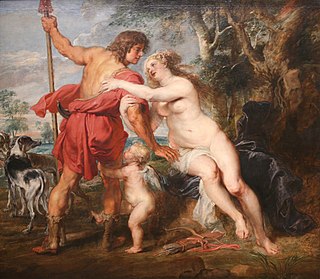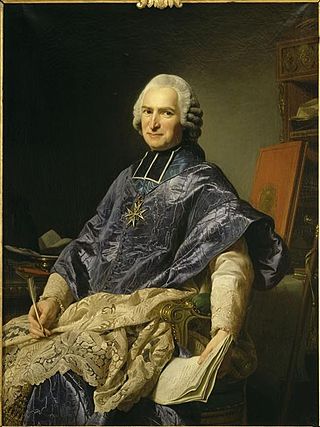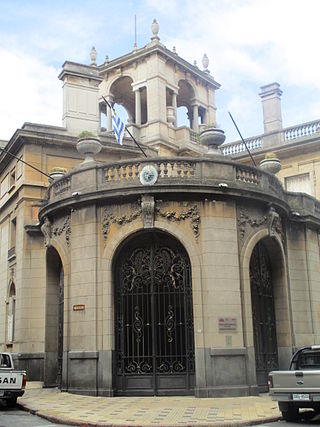Related Research Articles

The Baroque is a style of architecture, music, dance, painting, sculpture, poetry, and other arts that flourished in Europe from the early 17th century until the 1750s. In the territories of the Spanish and Portuguese Empires including the Iberian Peninsula it continued, together with new styles, until the first decade of the 19th century. It followed Renaissance art and Mannerism and preceded the Rococo and Neoclassical styles. It was encouraged by the Catholic Church as a means to counter the simplicity and austerity of Protestant architecture, art, and music, though Lutheran Baroque art developed in parts of Europe as well.
The Capetian dynasty, also known as the "House of France", is a dynasty of Frankish origin, and a branch of the Robertians. It is among the largest and oldest royal houses in Europe and the world, and consists of Hugh Capet, the founder of the dynasty, and his male-line descendants, who ruled in France without interruption from 987 to 1792, and again from 1814 to 1848. The senior line ruled in France as the House of Capet from the election of Hugh Capet in 987 until the death of Charles IV in 1328. That line was succeeded by cadet branches, the Houses of Valois and then Bourbon, which ruled without interruption until the French Revolution abolished the monarchy in 1792. The Bourbons were restored in 1814 in the aftermath of Napoleon's defeat, but had to vacate the throne again in 1830 in favor of the last Capetian monarch of France, Louis Philippe I, who belonged to the House of Orléans. Cadet branches of the Capetian House of Bourbon house are still reigning over Spain and Luxembourg.

Rococo, less commonly Roccoco, also known as Late Baroque, is an exceptionally ornamental and dramatic style of architecture, art and decoration which combines asymmetry, scrolling curves, gilding, white and pastel colours, sculpted moulding, and trompe-l'œil frescoes to create surprise and the illusion of motion and drama. It is often described as the final expression of the Baroque movement.

Baroque architecture is a highly decorative and theatrical style which appeared in Italy in the early 17th century and gradually spread across Europe. It was originally introduced by the Catholic Church, particularly by the Jesuits, as a means to combat the Reformation and the Protestant church with a new architecture that inspired surprise and awe. It reached its peak in the High Baroque (1625–1675), when it was used in churches and palaces in Italy, Spain, Portugal, France, Bavaria and Austria. In the Late Baroque period (1675–1750), it reached as far as Russia, the Ottoman Empire and the Spanish and Portuguese colonies in Latin America. In about 1730, an even more elaborately decorative variant called Rococo appeared and flourished in Central Europe.

The Régence was the period in French history between 1715 and 1723 when King Louis XV was considered a minor and the country was instead governed by Philippe d'Orléans as prince regent.

Regency architecture encompasses classical buildings built in the United Kingdom during the Regency era in the early 19th century when George IV was Prince Regent, and also to earlier and later buildings following the same style. The period coincides with the Biedermeier style in the German-speaking lands, Federal style in the United States and the French Empire style. Regency style is also applied to interior design and decorative arts of the period, typified by elegant furniture and vertically striped wallpaper, and to styles of clothing; for men, as typified by the dandy Beau Brummell and for women the Empire silhouette.
Monsieur is an honorific title that was used to refer to or address the eldest living brother of the king in the French royal court. It has now become the customary French title of respect and term of address for a French-speaking man, corresponding to such English titles as Mr. or sir.

The Kingdom of France in the early modern period, from the Renaissance to the Revolution (1789–1804), was a monarchy ruled by the House of Bourbon. This corresponds to the so-called Ancien Régime. The territory of France during this period increased until it included essentially the extent of the modern country, and it also included the territories of the first French colonial empire overseas.

Abbot Joseph Marie Terray was a Controller-General of Finances during the reign of Louis XV of France, an agent of fiscal reform.

Neoclassical architecture, sometimes referred to as Classical Revival architecture, is an architectural style produced by the Neoclassical movement that began in the mid-18th century in Italy and France. It became one of the most prominent architectural styles in the Western world. The prevailing styles of architecture in most of Europe for the previous two centuries, Renaissance architecture and Baroque architecture, already represented partial revivals of the Classical architecture of ancient Rome and ancient Greek architecture, but the Neoclassical movement aimed to strip away the excesses of Late Baroque and return to a purer and more authentic classical style, adapted to modern purposes.
Louis, Dauphin of France, or variations on this name, may refer to:

French Baroque architecture, sometimes called French classicism, was a style of architecture during the reigns of Louis XIII (1610–1643), Louis XIV (1643–1715) and Louis XV (1715–1774). It was preceded by French Renaissance architecture and Mannerism and was followed in the second half of the 18th century by French Neoclassical architecture. The style was originally inspired by the Italian Baroque architecture style, but, particularly under Louis XIV, it gave greater emphasis to regularity, the colossal order of facades, and the use of colonnades and cupolas, to symbolize the power and grandeur of the King. Notable examples of the style include the Grand Trianon of the Palace of Versailles, and the dome of Les Invalides in Paris. In the final years of Louis XIV and the reign of Louis XV, the colossal orders gradually disappeared, the style became lighter and saw the introduction of wrought iron decoration in rocaille designs. The period also saw the introduction of monumental urban squares in Paris and other cities, notably Place Vendôme and the Place de la Concorde. The style profoundly influenced 18th-century secular architecture throughout Europe; the Palace of Versailles and the French formal garden were copied by other courts all over Europe.

French architecture consists of numerous architectural styles that either originated in France or elsewhere and were developed within the territories of France.

The École Boulle is a college of fine arts and crafts and applied arts in Paris, France. It is located at 9-21, rue Pierre-Bourdan in the 12th arrondissement of Paris (France). It accepts students at both the secondary-school and tertiary levels.

The Louis XIII style or Louis Treize was a fashion in French art and architecture, especially affecting the visual and decorative arts. Its distinctness as a period in the history of French art has much to do with the regency under which Louis XIII began his reign (1610–1643). His mother and regent, Marie de' Medici, imported Mannerism from her homeland of Italy and the influence of Italian art was to be strongly felt for several decades.

Palacio Taranco, located in front of the Plaza Zabala, in the heart of the Old City of Montevideo, Uruguay, is a palace erected in the early 20th century during a period in which the architectural style was influenced by French architecture. It was designed by French architects Charles Louis Girault and Jules Chifflot León, who also designed the Petit Palais and the Arc de Triomphe in Paris. This building contains European furniture and drapings and currently contains the Museum of Decorative Arts in Montevideo. The palace is often used as a meeting place by the Uruguayan government.
In a monarchy, a regent is a person appointed to govern a state pro tempore because the monarch is a minor, absent, incapacitated or unable to discharge the powers and duties of the monarchy, or the throne is vacant and the new monarch has not yet been determined. One variation is in the Monarchy of Liechtenstein, where a competent monarch may choose to assign regency to their of-age heir, handing over the majority of their responsibilities to prepare the heir for future succession. The rule of a regent or regents is called a regency. A regent or regency council may be formed ad hoc or in accordance with a constitutional rule. Regent is sometimes a formal title granted to a monarch's most trusted advisor or personal assistant. If the regent is holding their position due to their position in the line of succession, the compound term prince regent is often used; if the regent of a minor is their mother, she would be referred to as queen regent.

The Louis XIV style or Louis Quatorze, also called French classicism, was the style of architecture and decorative arts intended to glorify King Louis XIV and his reign. It featured majesty, harmony and regularity. It became the official style during the reign of Louis XIV (1643–1715), imposed upon artists by the newly established Académie royale de peinture et de sculpture and the Académie royale d'architecture. It had an important influence upon the architecture of other European monarchs, from Frederick the Great of Prussia to Peter the Great of Russia. Major architects of the period included François Mansart, Jules Hardouin Mansart, Robert de Cotte, Pierre Le Muet, Claude Perrault, and Louis Le Vau. Major monuments included the Palace of Versailles, the Grand Trianon at Versailles, and the Church of Les Invalides (1675–1691).

The furniture of the Louis XV period (1715-1774) is characterized by curved forms, lightness, comfort and asymmetry; it replaced the more formal, boxlike and massive furniture of the Louis XIV style. It employed marquetry, using inlays of exotic woods of different colors, as well as ivory and mother of pearl.

The King's White Hound, the Chien Blanc du Roi in French, was a now extinct breed of scent hound from France. The breed was said to be the favourite of the French kings from Louis XI to Louis XIV.